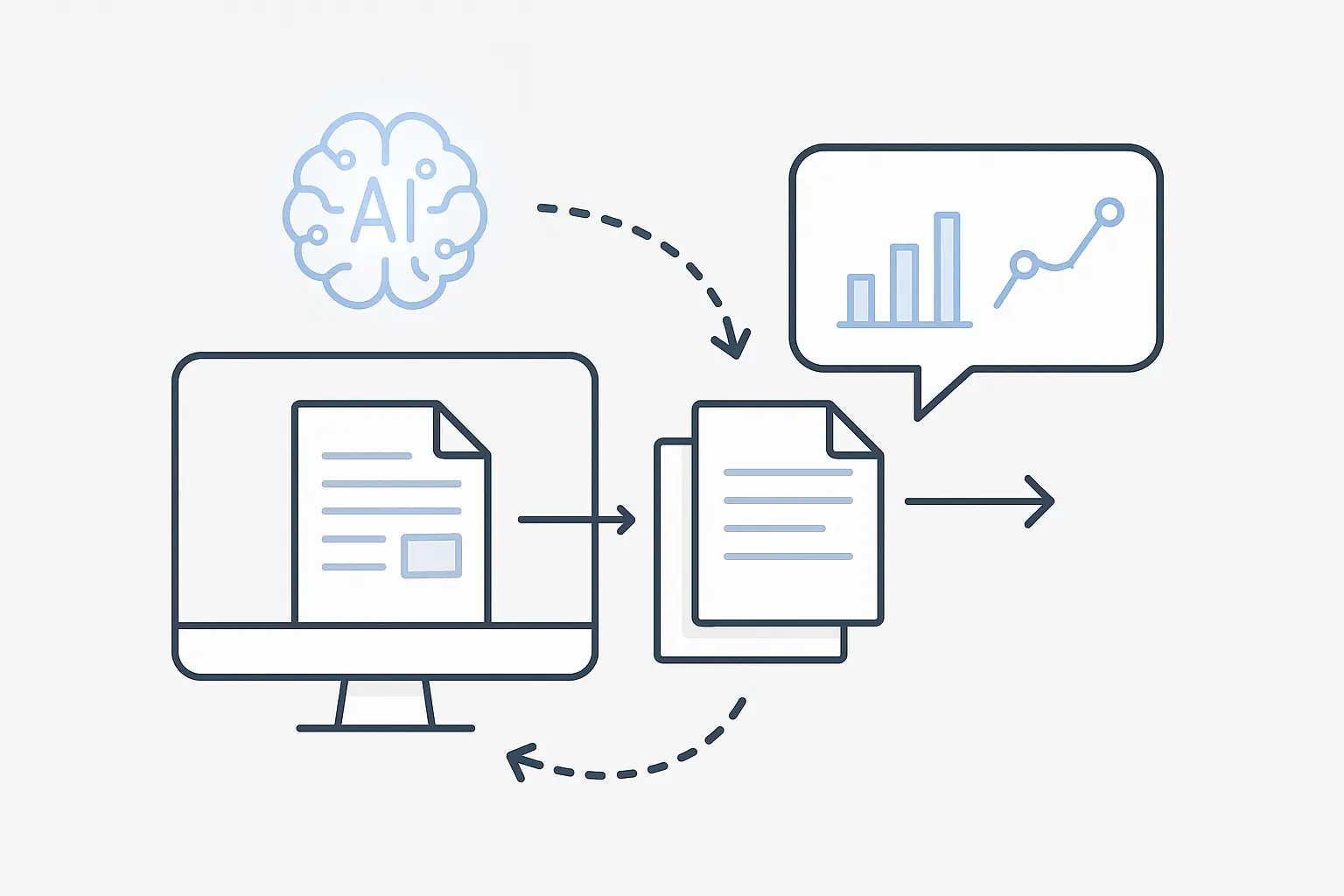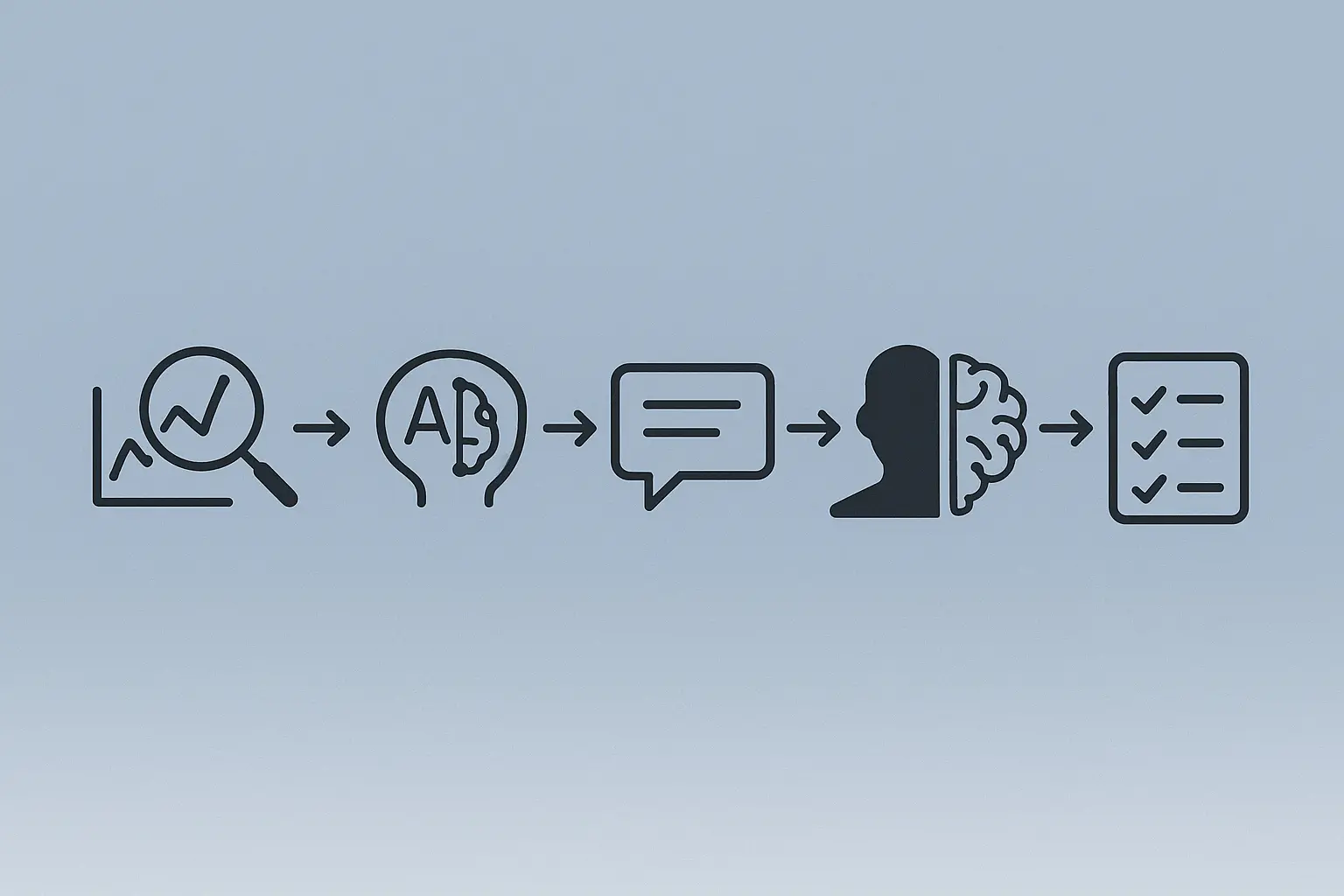The End of Uh-Oh Reports: How AI Commentary Transforms SEO Reporting
You know the feeling. It’s Sunday night, and you’re prepping the monthly SEO report for a key client. You pull up the dashboard, and your stomach sinks. A red arrow. Organic traffic is down 15%.
Immediately, your mind races. Was it an algorithm update? A competitor surge? A broken tracking code? You know there’s a logical reason, but you also know what the client will see: a number going in the wrong direction. You can already picture the inevitable one-line email: “What happened here?”
Reporting is simple when everything is up and to the right. But the real test of an agency’s value isn’t celebrating the wins—it’s navigating the inevitable fluctuations with confidence and clarity.
What if your reports could do the heavy lifting for you? What if they could explain the dips before the client even has a chance to ask? Welcome to the new era of client reporting, where AI-generated commentary turns your data dumps into strategic narratives, building trust even when the numbers are down.
Beyond the Numbers: Why Raw Data Is a Recipe for Client Anxiety
For years, agency reports have been a collection of charts and graphs. We export them from our tools, paste them into a branded template, and hope the client understands what they’re seeing.
The problem? Most clients don’t. They’re busy running their business. A chart without context is just noise, and a red arrow without an explanation is a cause for alarm. This is a classic case of being data-rich but insight-poor.
In fact, a Forrester report found that while companies are eager to be data-driven, 74% say their organizations are drowning in data but starving for actual insights. Sending a client a dashboard full of raw data is like handing them the ingredients to a cake and expecting them to know how to bake it. They need the recipe—the story behind the numbers. Making narrative a priority over raw numbers in your agency SEO reporting strategy (https://jvglabs.com/blog/agency-seo-reporting-strategy) is no longer a luxury; it’s essential for client retention.
The Anatomy of a Performance Fluctuation
Before you can explain a dip, you need to understand its source. Performance fluctuations are a natural part of the SEO ecosystem. They’re not necessarily a sign of failure but a reflection of a dynamic digital environment.
Here are the most common culprits:
Google Algorithm Updates
These are the earthquakes of the SEO world. Google constantly refines its algorithms to deliver better results, and sometimes these updates cause temporary volatility as the search results recalibrate. A sudden dip across multiple keywords often points to a recent update.
Seasonality and Market Trends
A landscaping company’s search traffic will naturally dip in the winter. A tax firm’s traffic will spike in the spring. Understanding these seasonal ebbs and flows is crucial for setting realistic expectations.
Competitor Activity
SEO isn’t a solo sport. If a direct competitor launches a massive content campaign or a new product, it can temporarily disrupt the search landscape and impact your client’s visibility.
Technical Glitches or Site Changes
Sometimes the issue is internal. A website migration, a change in URL structure, or even a broken analytics tracking code can cause data to drop off suddenly. In these cases, transparency is non-negotiable.
Introducing AI-Generated Commentary: Your Automated Strategist
So, how do you explain these complex scenarios consistently and at scale? Manually writing a detailed analysis for every client report is time-consuming and prone to human error. That’s where AI-generated commentary changes the game.
Imagine your reporting platform not just pulling data, but interpreting it. It sees the 15% dip in traffic, cross-references it with industry chatter about a potential Google update, and automatically writes a concise, human-readable summary.

This isn’t science fiction; it’s the application of AI to a high-value, repetitive task. Accenture research highlights that AI has the potential to boost productivity by 40% or more by automating routine tasks and augmenting human capabilities. For agencies, this means freeing up your best minds from the drudgery of report writing to focus on what really matters: strategy and client relationships.
How AI Commentary Builds Trust and Manages Expectations
Integrating automated narrative into your reports does more than save time. It fundamentally changes the client conversation from reactive to proactive.
Proactive Explanations, Not Reactive Excuses
When the report itself contains the explanation, you get ahead of the questions. The client sees the dip, but in the next paragraph, they read the context. This demonstrates foresight and control, positioning your agency as a strategic partner that’s constantly monitoring the landscape.
Translating Data into Business Narratives
AI commentary can turn SEO jargon into a business-focused story. Instead of: “Keyword rankings for ‘blue widgets’ dropped from position 3 to 8.” The AI narrative says: “We observed a minor dip in rankings for ‘blue widgets’ this month, coinciding with a broad Google algorithm update that impacted the e-commerce sector. Our strategy is already adapting by strengthening topical authority around related keywords, and we anticipate stabilization in the next period.”
Maintaining Consistency and Quality at Scale
Whether you have 5 clients or 50, every report can deliver the same level of detailed, data-backed insight. This consistency is the hallmark of a scalable white-label SEO service (https://jvglabs.com/services/white-label-seo), ensuring every client receives top-tier analysis, regardless of which account manager is handling their account.
Putting It Into Practice: A 3-Step Framework
Adopting AI-powered reporting doesn’t have to be complicated. It boils down to a simple, repeatable process.
Step 1: Integrate the Right Data Sources
For AI to generate meaningful insights, it needs clean, comprehensive data from essential sources. That means connecting your reporting system to Google Analytics 4, Google Search Console, and your preferred rank-tracking tools.
Step 2: Define the ‘Triggers’ for Commentary
You can set rules for when commentary should be automatically generated. For instance, you might set a trigger for any metric that changes by more than +/- 10% month-over-month. When a trigger is hit, the AI analyzes and explains the variance.
Step 3: Review and Refine
The best systems combine automation with human expertise. The AI can generate the initial draft of the commentary—the “what” and the “why.” A human strategist then quickly reviews it to add nuance, client-specific context, or strategic next steps. This hybrid approach ensures accuracy and a personal touch.
 Frequently Asked Questions (FAQ)
Frequently Asked Questions (FAQ)
Is AI-generated commentary just generic, robotic text?
Not at all. Modern AI analyzes your client’s specific data in the context of broader trends. It identifies anomalies and patterns unique to their performance and delivers highly relevant, customized explanations that go far beyond generic templates.
Will this technology replace my account managers?
No, it empowers them. By automating the time-consuming process of data analysis and summary writing, AI frees your account managers to focus on higher-value activities like strategic planning, client communication, and strengthening relationships. It’s about augmentation, not replacement.
Can the AI understand our client’s specific industry or seasonality?
Yes. The more historical data the AI has access to, the better it becomes at recognizing seasonal patterns and industry-specific trends. It learns what “normal” looks like for your client, allowing it to more accurately identify and explain deviations.
How do I get started with AI-powered reporting?
The easiest way is to work with an SEO partner or platform where these capabilities are already built-in. Look for solutions that offer automated, white-label reporting with integrated commentary features. The goal is seamless integration, not adding another complex tool to your stack.
From Reactive Reporting to Proactive Partnership
The way agencies communicate value is evolving. Simply presenting data is no longer enough. The future belongs to those who can interpret that data and tell a compelling story—a story of challenges, adaptations, and long-term growth.
By embracing AI-generated commentary, you transform your reports from a dreaded monthly chore into a powerful tool for client education and retention. You shift from a vendor providing a service to a partner delivering strategic guidance. And in the agency world, that makes all the difference.
Ready to transform your service delivery with intelligent automation? Explore our AI-powered SEO solutions for agencies (https://jvglabs.com/solutions/ai-powered-seo) and discover a smarter way to scale.

